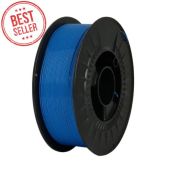We use cookies to make your experience better. Read more
How to Print ASA Filament: A Practical Guide for Durable Prints
ASA filament is one of the top choices when it comes to printing strong, weather-resistant 3D models. While it shares some characteristics with ABS, it offers significantly better UV and weather resistance, making it perfect for outdoor use. If you're looking to master how to print ASA filament without dealing with issues like warping or poor adhesion, this guide is for you.
What Makes ASA Filament Different?
Acrylic Styrene Acrylonitrile (ASA) is an engineering thermoplastic similar in structure to ABS. However, it was developed specifically to improve upon ABS by enhancing its weather resistance and UV stability. That makes ASA ideal for outdoor parts such as automotive components, garden tools, dashboard panels, and boat fittings.
- Acrylonitrile: Provides chemical and heat resistance.
- Styrene: Adds rigidity and dimensional stability.
- Acrylate: Enhances impact strength and weather resistance.
Its glass transition temperature is around 105°C, making it suitable for applications exposed to high temperatures. It's available in fewer color options than PLA or ABS but offers a smooth satin finish that can be further improved with acetone vapor smoothing.
Ideal Printer Settings for ASA
Printing ASA filament requires higher temperatures and careful environmental control. Here are the essential printer settings:
- Nozzle temperature: 240–260°C (Start around 250°C and adjust +/- 5°C as needed.)
- Bed temperature: 90–110°C (Minimum 80°C to avoid warping.)
- Cooling fan: Off or very low (5% to 50%)
- Print speed: Begin at 30–50 mm/s and adjust based on results
- Enclosure: Highly recommended, especially for larger parts
A heated bed is non-negotiable. It helps maintain the necessary temperature range and keeps prints from warping.
Bed Adhesion Tips
Getting the first layer right is critical when printing with ASA. Good bed adhesion prevents warping and improves overall print quality. Here are proven techniques:
- Use a clean, level bed. Wipe with isopropyl alcohol to remove residue.
- Apply adhesives like glue sticks, or a slurry made of ASA and acetone.
- Consider adding a brim to increase bed contact surface.
Recommended bed surfaces include:
- Glass beds (especially when used with adhesives)
- Kapton tape (heat-resistant and textured)
- Blue painter's tape (cost-effective and commonly available)
Avoiding Common ASA Printing Issues
Warping
Warping often results from uneven cooling and poor first layer adhesion. Use an enclosure to maintain consistent heat, and ensure your bed is properly heated and leveled. Printing with a brim or raft can help larger parts stay anchored.
Layer Splitting and Cracking
These occur due to residual stress. Printing in a heated or enclosed chamber drastically reduces this issue. Keep the cooling fan off or on a very low setting.
Nozzle Clogs
ASA prints at high temperatures, so regular nozzle maintenance is important. If you're switching from a filament with a lower melting point, purge the hotend thoroughly at the higher ASA temperature.
Stringing
Excessive nozzle temperature or improper retraction settings can cause stringing. Lower the print temperature slightly and fine-tune retraction speed and distance.
Safe Ventilation Practices
ASA emits toxic fumes during printing due to the styrene content. To ensure safety:
- Print in a well-ventilated space.
- Use an enclosure with proper exhaust systems or air filters.
- Avoid printing in living areas.
- Keep windows open and use fans to circulate air.
Proper Filament Storage
ASA is mildly hygroscopic, which means it absorbs moisture over time. Moisture in the filament can lead to popping noises during printing, poor surface quality, and weak layer adhesion. Follow these best practices:
- Store ASA in a sealed container with desiccants.
- Avoid exposing it to direct sunlight or high humidity.
- Dry the filament before use using a filament dryer or a conventional oven (carefully monitored at low temperature).
Post-Processing Techniques
Once your print is complete, here are ways to enhance its appearance and functionality:
Removing Prints
- Wait for the bed to cool to room temperature.
- Use a spatula or scraper to gently lift the print.
Smoothing
- Use acetone vapor smoothing for a refined, satin finish.
- Sand prints with varying grit (start coarse, finish fine). Wet sanding is preferred to reduce heat and dust.
Painting
- ASA can be painted using acrylic or enamel paints.
- Sand and prime surfaces before painting.
Gluing and Assembly
- Use acetone, super glue, or two-part epoxies for joining parts.
- Sand contact surfaces to improve adhesion.
Getting Started with ASA Printing
To summarize, here are the most important tips for successful ASA printing:
- Always use a heated bed and an enclosed printer.
- Maintain a consistent and well-ventilated environment.
- Start with slower print speeds and adjust based on results.
- Keep filaments dry and store them properly.
Despite its challenges, ASA filament is an excellent material for creating durable, UV-resistant outdoor parts. Its mechanical properties and long-term performance make it a worthy upgrade from ABS or PLA when strength and weather resistance matter.
At 3D Trček, we provide tailored material solutions including thermoplastic elastomers, ABS, PP, PE, and more. We support you from tooling to final product, and our experienced team is always ready to offer expert advice. Visit 3dtrcek.com to explore our range of materials and services.
0 Comment(s)



Please complete your information below to login.
Sign In
Create New Account